Raia, Goa
Raia (Rai) is a scenic village on the outskirts of Margao in Salcete Taluk in South Goa District of Goa State, India. It is located six kilometres east from the district headquarters of Margao and 35 kilometres from the State capital Panaji.
Raia | |
|---|---|
town | |
 Raia Location in Goa, India  Raia Raia (India) | |
| Coordinates: 15°18′N 73°58′E | |
| Country | |
| State | Goa |
| District | South Goa |
| Government | |
| • Body | Panchayat |
| Population | |
| • Total | 10,706 |
| Languages | |
| • Official | Konkani |
| Time zone | UTC+5:30 (IST) |
| PIN | 403720 |
| Telephone code | 0832 |
| Vehicle registration | GA |
| Nearest city | Margao |
| Vidhan Sabha constituency | Curtorim & Nuvem |
| Website | goa |
Location
Gogol (two kilometres), Margao (three kilometres), and Aquem Margao (three kilometres) are the nearby areas to Raia. Raia is surrounded by Mormugao taluk towards the west, Quepem taluka towards its south, Ponda taluka towards the north. Raia village lies close to the villages of Loutulim, Ambora, Rachol and Maina.
It lies at the border of the North Goa District and the South Goa District. Ponda is North Goa District is just across Raia. Since it lies near the Arabian Sea, the weather can be humid for part of the year.
Raia village falls under the Goa Assembly constituency of Curtorim for electoral purposes. Raia's PIN code is 403720 and its postal office is Raia itself.
Population
For the purposes of the Census, Raia is considered to be a "census town" (though it is a panchayat area) and in 2011 had a population of 10,706—comprising 5,256 males and 5,450 females as per report released by Census India 2011.[1]
Male literacy was 90.15% and female, 84.72%. There were 1037 women for every 1000 males, indicating perhaps the high out-migration from the area, mainly for temporary employment overseas and elsewhere. Raia had 1106 children under six years of age in 2011, of whom 585 were male and 521 female.
The Christian population of Raia in 2011 was 7,574 (70.75%) and there were 2,399 (22.4%) Hindus and 705 (6.59%) Muslims. The Scheduled Tribe population was 2,968 and thre were 66 Scheduled Caste members, according to the censusndia.co.in site.
Raia has a significant agrarian population, whose lives are sometimes affected by the vagaries of the monsoons.[2]
History
Pe. Jorge Paulino da Piedade Sequeira, a priest from the area, wrote a book titled Raia e Camorlim. Para a História das Aldeias, (Raia and Camorlim: About the History of the Villages), published by the Xaverian Press at Pilar in 1972. Camorlim is a village between Raia and Loutolim[3]
According to former Indian Union minister Eduardo Faleiro, Raia "derives its name from Agni Mukha Roy, one of the earlier Kadamba kings who established his headquarters in this village."[4] Faleiro cites Fr. Jorge Sequeira to suggest that, in the past, the village was known variously as Rayanagara, Rajapur and Rayapur, and with the decline of the Kadamba dynasty it became known simply as Raya and then Raia.[4]
The earlier ruling empire of the Kadambas are believed to have brought the deity of Kamakshi to the village, the temple of which was destroyed during Portuguese rule, with the deity being shifted across the river to Rai Shiroda, a locality on the other bank of the river beyond the then Portuguese territory.[4]
Raia was the first village in Salcette to have been Christianised, when its populace was converted en masse to Christianity in 1560.[5]
Raia (with Margao, Verna, Curtorim, Loutolim, Benaulim, Betalbatim, Colva, Cortalim, Quelossim, Nagoa and Sancoale-Dabolim) was among 12 villages of Salcete represented at the Camara Geral do Concelho, or the general assembly of Communidades at the sub-district or taluka level. The Camaras Gerais ou Agrarias were extinguished by the Code of Communidades of 1904 and substituted by Administrators of Communidades.[4] The Comunidades were cooperative associations governed by heads of family, called gaunkars. Originally based on collective ownership of land by a group of villagers, this system saw a certain portion of the total agrarian produce earmarked for village welfare, a part as the government share, and the balance distributed among the members as dividend or jono (zonn). Over time, Comunidades lost their original character and turned into mere societies of gaunkars who had membership based on accident of birth. Non-gaunkars who came subsequently and also contributed to the development of the village had no say in the Comunidades, with many gaunkars living outside the area from which they are entitled to jono. Women family members also have no right to membership. Comunidades ceased to be collective farming societies, and village development activities which were the preserve of the gaunkaris (a pre-Portuguese name for the Comunidades) and now entrusted to the gram panchayat.[4]
Raikars (villagers of Raia) are known as wag (tigers).[4]
Church
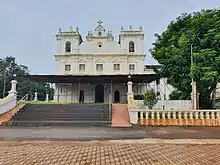
After conversions to Christianity, locals helped build a church dedicated to Nossa Senhora das Neves or Our Lady of the Snows in 1699.[6]
Harvest festival
Raia hosts a harvest feast, locally called the Konsache Fest in Konkani, which is celebrated on 5 August every year.[7] The feast Mass is celebrated at Our Lady of Snows Church, Raia.[8]
Raikars, Konkani song and other features
Raikars of the skilled Daivadnya Brahmin (sonar) community were originally from Raia, Goa, and hence some members of the community carry the village's name as part of their surname — Raikar.
Raia, together with the nearby villages of Curtorim and Loutolim, was home to, and the nursery of, many of the Mando (plural mandde) form of prominent Goan Konkani song.[9]
The village is known for some prominent food outlets, including the prominent local Nostalgia restaurant. Nostalgia has been called "a restaurant that has made its name by serving authentic Portuguese cuisine",[10] In other parts of the village, small but noted bakeries also draw customers. Some of the local institutions have deployed solar power.[11]
Spanish flu in 1918-19

The village of Raia was one of the villages in the state of Goa which is believed to have suffered badly due to the Spanish flu pandemic around 1918-1919.[12]
Andrew Pereira argues that Raia was among the villages most badly hit in Goa due to the 1918-19 Spanish flu pandemic. A memorial pillar stands tall outside the present cemetery of Raia, constructed in memory of the Spanish flu victims a year later in 1919. The aftermath of the Spanish flu, as per reports, lasted for a year till 1919.[13]
The nearly nine feet tall tombstone bears the words – ‘E.M. (EM MEMORIA) DAS VICTIMAS DE GRIPE DE 1918 (In memory of the victims of flu in 1918).[14]
Gallery
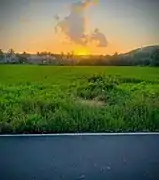 Raia, the setting
Raia, the setting Scenic Raia
Scenic Raia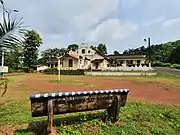 Chapels of Raia
Chapels of Raia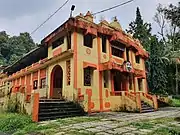 Temple in the village
Temple in the village Raia view
Raia view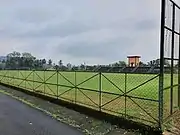 View from Raia
View from Raia Convent in the area
Convent in the area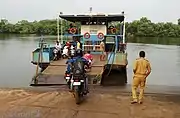 Raia-Rachol ferry
Raia-Rachol ferry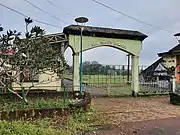 Raia Sports Complex
Raia Sports Complex Old local homes
Old local homes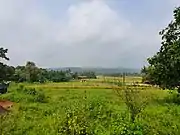 Green fields
Green fields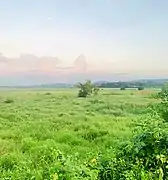 In the village
In the village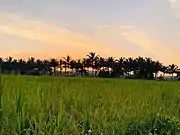 Around the village
Around the village Fish-curry-rice from the village
Fish-curry-rice from the village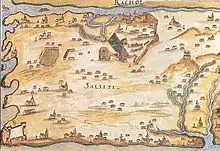 Centuries-old map of the area including nearby Rachol
Centuries-old map of the area including nearby Rachol
Notes
- "District Census Handbook 2011" (PDF). ETrace. 11 October 2020. Archived (PDF) from the original on 14 November 2019. Retrieved 11 October 2020.
- "Heavy rains pelt down lives of farmers as their ready-to-harvest fields are left inundated". oHeraldo. Retrieved 11 October 2020.
- Jan 3, TNN / Updated:; 2017; Ist, 20:35. "Small, But Special | Goa News - Times of India". The Times of India. Retrieved 12 October 2020.CS1 maint: extra punctuation (link) CS1 maint: numeric names: authors list (link)
- "Raia, my village". oHeraldo. Retrieved 12 October 2020.
- Sarasvati's Children: A History of the Mangalorean Christians, Alan Machado Prabhu, I.J.A. Publications, 1999, p. 101
- "EVANGELIZATION OF THE VILLAGE OF RAIA". Ivosouza's Blog. 13 January 2009. Retrieved 11 October 2020.
- "'Konsachem fest' celebrated at Raia". oHeraldo. Retrieved 11 October 2020.
- "Harvest and snow". The Goan EveryDay. Retrieved 11 October 2020.
- Dec 21, Newton Sequeira /; 2014; Ist, 01:46. "The true soul of Goa's South | Goa News - Times of India". The Times of India. Retrieved 11 October 2020.CS1 maint: numeric names: authors list (link)
- "Portugal endures & endears, as links go beyond boundaries". oHeraldo. Retrieved 12 October 2020.
- "Solar power plant inaugurated at Raia". oHeraldo. Retrieved 12 October 2020.
- Fern, Paul; Apr 13, es / TNN / Updated:; 2020; Ist, 08:38. "Mass graves, scattered bones, Goa's traumatic memories of the 1918 Spanish flu | Goa News - Times of India". The Times of India. Retrieved 11 October 2020.CS1 maint: extra punctuation (link) CS1 maint: numeric names: authors list (link)
- Pereira, Andrew (12 October 2020). "Lost Stories Goa -- Spanish Flu". YouTube.
- Desk, N. T. (18 September 2020). "COVID cases in Raia remind locals of Spanish flu episode". The Navhind Times. Retrieved 11 October 2020.